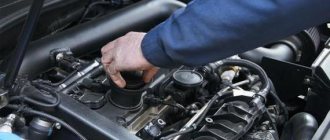Table for cars in 2021
The corresponding OKOF codes for vehicles, their depreciation groups and the useful life of vehicles put into operation from 01/01/2017 are shown in the table below. It is relevant in 2021.
| Car type | OK 013-2014 (OKOF) | Depreciation group | Useful life |
| Passenger car with a gasoline engine up to 3,500 cc. cm inclusive (3.5 l) | 310.29.10.21 310.29.10.22 | Third | From 37 to 60 months inclusive |
| Passenger car with a gasoline engine with a volume of over 3,500 cc. cm (3.5 l) | 310.29.10.22 | Fifth | From 85 to 120 months inclusive |
| Passenger car with diesel engine | 310.29.10.23 | ||
| Truck (flatbed, tractor or van) with a maximum weight of not more than 3.5 tons inclusive | 310.29.10.41.111 310.29.10.42.111 | Third | From 37 to 60 months inclusive |
| Truck with a maximum weight of over 3.5 tons | 310.29.10.41.112 310.29.10.41.113 310.29.10.42.112 310.29.10.42.113 | Fifth | from 85 to 120 months inclusive |
| Dump trucks, fuel trucks, timber trucks and some other trucks, regardless of maximum weight | 310.29.10.41.120 310.29.10.42.120 | Fourth | From 61 to 84 months inclusive |
Shock absorption groups for trucks and buses
For buses and trucks, everything depends solely on their technical characteristics.
| Type of vehicle | Useful life | Depreciation group | |
| Length no more than 7.5 m | Over 3 years up to 5 years inclusive | ||
| Length over 7.5 m up to 16.5 m inclusive | Over 5 years up to 7 years inclusive | ||
| Extra large - over 16.5 m long up to 24 m inclusive | Over 7 years up to 10 years inclusive | ||
| Truck | Truck with lifting capacity up to 0.5 t | Over 3 years up to 5 years inclusive | |
| and general purpose | General purpose trucks with a carrying capacity over 5 tons | Over 7 years up to 10 years inclusive | |
| Truck tractors | |||
| Other vehicles: trucks, road tractors for semi-trailers (general purpose vehicles: flatbeds, vans, tractors; dump trucks) | Over 5 years up to 7 years inclusive | ||
When choosing a depreciation group, it is important to correctly determine the type of vehicle. This information must first be looked for in lines 2 - 4 of the vehicle passport (PTS) (Letters of the Ministry of Finance of Russia dated 03/19/2010 N 03-05-05-04/05, dated 01/17/2008 N 03-05-04-01/1 ).
If in line 4, for example, type “C” is indicated, in line 3 it says “Truck”, and the second digit of the vehicle brand number in line 2 is “3”, then there is no doubt: we have a truck in front of us (Industry standard OH 025 270-66; Appendix No. 3 to the Methodological Recommendations, approved by Order of the Ministry of Transport of Russia dated March 14, 2008 N AM-23-r). If an organization bought an imported car, then there may not be a digital designation of its brand in line 2. For example, it simply says “Mercedes-Benz Actros”. Then you need to look at lines 3 and 4.
Note By the way, sometimes in line 3 of the PTS, traffic police officers write different names for the same vehicle. For example, in the PTS for Sobol-Barguzin there are the following options: “cargo-passenger”, “specialized passenger vehicle with 6 seats”, “station wagon”, etc. Which can completely confuse an accountant. In this case, the only correct guideline is the second digit in the vehicle model.
Sometimes from lines 2 or 3 it follows that the car is not a passenger car (truck, bus, special, etc.), and in line 4 of the PTS there is category “B”. Some accountants believe that this category means that the car is a passenger car. After all, normal rights are required to operate it! Some organizations managed to defend this position in court. For example, once a court considered cars to be passenger cars only because category “B” was indicated in their title (Resolution of the Federal Antimonopoly Service of the Moscow Region dated January 14, 2011 N KA-A40/17115-10). But this is rare. Category “B” for a vehicle does not mean at all that this is a passenger car. What other courts directly point out (Resolutions of the Federal Antimonopoly Service of the North Caucasus Region dated December 9, 2010 in case No. A32-10605/2008-12/122; Federal Antimonopoly Service UO dated November 24, 2011 No. F09-7735/11). By the way, the Ministry of Finance, referring to one of the Definitions of the Supreme Arbitration Court of the Russian Federation (Definition of the Supreme Arbitration Court of the Russian Federation dated October 14, 2009 N VAS-11908/09), directly indicates that the GAZ-2705 (“Gazelle-Business”) belongs to the category of trucks (despite the fact that , that in line 4 of the PTS of such cars, category “B” is indicated) (Letter of the Ministry of Finance of Russia dated October 21, 2010 N 03-05-06-04/251). And all these disputes are far from idle. As you probably know, the type of vehicle is also very important when calculating vehicle tax. So, with the same engine power, for example, from 100 to 150 horsepower, the base rate for a passenger car is 3.5 rubles. per 1 horsepower, for a bus - 5 rubles/l. s., for a truck - 4 rubles/l. With. (Clause 1 of Article 361 of the Tax Code of the Russian Federation).
Note Basic rates of transport tax can be increased or decreased by law of a constituent entity of the Russian Federation (but not more than 10 times) (Clause 2 of Article 361 of the Tax Code of the Russian Federation).
In addition to passenger cars, category “B” also includes small buses and trucks. So if your “Gazelle”, “Sobol-Barguzin” or other similar car is intended for transporting goods and this is indicated in the title, and the second digit of the vehicle brand is not “1” or “2”, then it is safer to recognize the car as a cargo vehicle. And its place is in the 4th depreciation group, and not in the 3rd. If the second digit is “2”, then we have a bus in front of us (3rd depreciation group). And the second number “7” in the car brand means that it is a cargo van and should be classified as the 4th depreciation group.
Attention!
The type of vehicle directly affects not only its useful life, but also the amount of transport tax.
By the way, tax specialists are not averse to playing with the law, turning it in one direction or the other, depending on what is beneficial to them in a particular situation. Thus, when demanding a transport tax from the owners of the controversial Gazelles and Sobols, they will insist that these cars have nothing to do with cars. However, when inspectors checked the manufacturer of the same cars, they began to prove the opposite. And it is no coincidence - only when selling cars you need to pay excise tax. The inspectorate assessed additional excise taxes and VAT to Automobile LLC, considering the sold cars of the GAZ-2217, 22171, 22177, 221717, 3221, 32217 brands to be cars. However, the courts did not support the tax service (Resolution of the Federal Antimonopoly Service of the North-West District dated December 10, 2010 in case No. A56-7511/2010 ). They recommended looking at the type of car (the second digit of the model). And since it is “2”, then in front of us is not a passenger car, but a bus. If for some reason you cannot find clear information in the PTS about what type of vehicle your vehicle is, this can be considered as an irremovable ambiguity that should be interpreted in your favor (Clause 7 of Article 3 of the Tax Code of the Russian Federation). But it can be much easier to clarify the situation by sending a request to the manufacturer (its representative) or to the traffic police. This request can be made in any form. For example, you can use the template below.
Once you put your car into service, you can write off the depreciation bonus as an indirect expense in your tax accounting. The good news is that the limit for such a premium is the same for all cars: it cannot be more than 30% (Clause 9 of Article 258 of the Tax Code of the Russian Federation). At least on this issue you will not have any doubts.
Approved by Decree of the Government of the Russian Federation No. 1 of 01/01/02.
Starting from 01/01/17, an updated version of this legislative act is in force (put into force by government decree No. 640 of 07/07/16). The amendments concern new OKOF codes used from 2021.
What depreciation periods are currently established for freight transport? In what order are SPI (useful lives) approved for cars purchased before 2021? Let's look at the features of choosing a depreciation group for a truck in accordance with current legislation.
Explanation
Note that most passenger cars belong to the 3rd depreciation group. Consequently, their useful life ranges from 3 to 5 years inclusive, that is, from 37 to 60 months.
Take data on the type of vehicle, its engine size and permitted weight from the vehicle title.
In addition, please note that due to the new wording of paragraph 4, paragraph 1, art. 259 of the Tax Code of the Russian Federation (introduced by Law No. 325-FZ of September 29, 2019) from January 1, 2020, organizations received the right to switch from one method (linear or non-linear) of depreciation to another, but not more than once every 5 years.
Note that previously the law established a 5-year period only when switching from a non-linear to a linear method of accounting for depreciation.
Read also
20.11.2019
Determining the depreciation group of a passenger car
The depreciation group of a passenger car depends not only on the displacement of its engine, but also on its class.
As you can see, if the engine capacity of your new car exceeds 3.5 liters, then its depreciation group is definitely 5th. There will also be no difficulties in determining the group for inexpensive small cars: budget cars cannot get into the top class. Most likely, they will fall into the 3rd depreciation group. The most difficult thing is to decide on the shock absorption group of respectable ones with an engine capacity of up to 3.5 liters. Thus, doubts may arise, in particular, when purchasing an Audi A8 or Nissan Teana. To what class should they be classified: higher or other? There are no clear guidelines in the OS Classification.
Attention!
The class of a car is also important when classifying it as an energy-efficient OS for the possibility of using accelerated depreciation and property tax benefits (Subclause 4 of clause 1 of Article 259.3, clause 21 of Article 381 of the Tax Code of the Russian Federation).
There is a rather old Letter from the Customs Committee, in which it is recommended that executive class cars be classified as the highest class (Letter of the State Customs Committee of Russia dated February 26, 1997 N 04-30/3515). Tax authorities also refer to this Letter from the State Customs Committee (Letter of the Federal Tax Service of Russia for Moscow dated December 21, 2011 N 16-15/). What is considered an executive car is decided individually, taking into account the prestige of the brand, price, interior comfort, and so on. For example, the hybrid Lexus CT 200h has a 1.8 liter gasoline engine, and the price of the car can reach up to 1.7 million rubles. Of course, it is possible to classify such a car into the small class, but this will certainly raise questions among the inspectors. They can involve specialists from the manufacturing company as experts. And they will probably confirm to the tax authorities (as they already confirmed to us in a telephone conversation) that all Lexus cars are of the executive class, and therefore of the highest class. There is another approach: only cars with a length of over 4.9 m are classified as the highest class. It was proposed by the Ministry of Economy in 1998 (Methodological Guide RD 37.009.015-98, approved by the Ministry of Economy of Russia on June 4, 1998). And in one legal dispute, the organization managed to defend its position - referring to the short length of its car, it argued that the car did not belong to the highest class (and therefore, it did not need to be included in the 5th depreciation group (Resolution 17 AAS dated 08.12.2008 N 17AP-8900/2008-AK)). True, there are also opposite court decisions (Resolution 11 of the AAS dated February 24, 2011 in case No. A72-6500/2010). At the same time, if your car is longer than 4.9 m, but does not qualify for the highest class (it could be an inexpensive station wagon), then you can safely ignore the recommendations of the Ministry of Economy. The fact is that the Methodological Guide itself was neither registered nor published anywhere. And therefore, it cannot establish any rules of the game.
Which depreciation group does a passenger car belong to?
The distribution of passenger vehicles into appropriate groups depends on the class of the car, engine size, and purpose. Correctly determining which depreciation group a passenger car belongs to will allow the accountant to accurately calculate the amount of depreciation, and therefore accrue tax payments to the budget in accordance with the requirements of the tax legislation of the Russian Federation.
The table in the next section will help you determine which depreciation group a passenger car belongs to based on its main characteristics. The necessary information can be taken from the transport documentation - PTS (vehicle passport). If there are disagreements and ambiguities regarding the type of vehicle, you can make an official request to the manufacturer or to the territorial division of the traffic police.
Depreciation groups for passenger vehicles. Table
In the process of assigning a specific car model to a depreciation group, you need to focus on the engine size of the vehicle, the type and category of the vehicle. Additionally, you should take into account the total cost of the car, since it is unlikely that it will be possible to classify the Lada Largus and, for example, a luxury Lexus into the same depreciation group.
Table of depreciation groups for passenger vehicles - according to 2021 data.
| Group | SPI (years) | Current OKOF | Car class |
| Passenger vehicles, engine capacity is not specified according to the new Classifier. | |||
| Fourth | Passenger vehicles intended for transporting disabled people (small class), engine size not specified. | ||
| Passenger vehicles of large and higher classes, with an engine capacity of more than 3.5 liters. |
Until 01/01/17, most passenger vehicles also belonged to group 3, so there were no special changes in this regard for accountants. When establishing a car class, it is recommended to be guided by the international gradation (6 classes - mini A, small B, lower middle C, middle D, upper middle E, highest F).
Note! The depreciation group of a truck crane is determined depending on the type of equipment specified. Thus, lifting boom cranes belong to group 2; stacker cranes for group 5; lifting - to group 7. Since the depreciation group is not approved specifically for automobile cranes, it is necessary to establish the useful life in accordance with the technical purpose of such vehicles.
Car depreciation group
for tax purposes it is not always easy to determine unambiguously. Meanwhile, a mistake made in this case threatens to be wrong. As a result, there are errors in calculating income taxes. In addition, incorrect determination of the type of vehicle can lead to an error in calculating the transport tax. Therefore, we will pay special attention to this issue. We will not talk about cars for disabled people and special equipment in the article.





